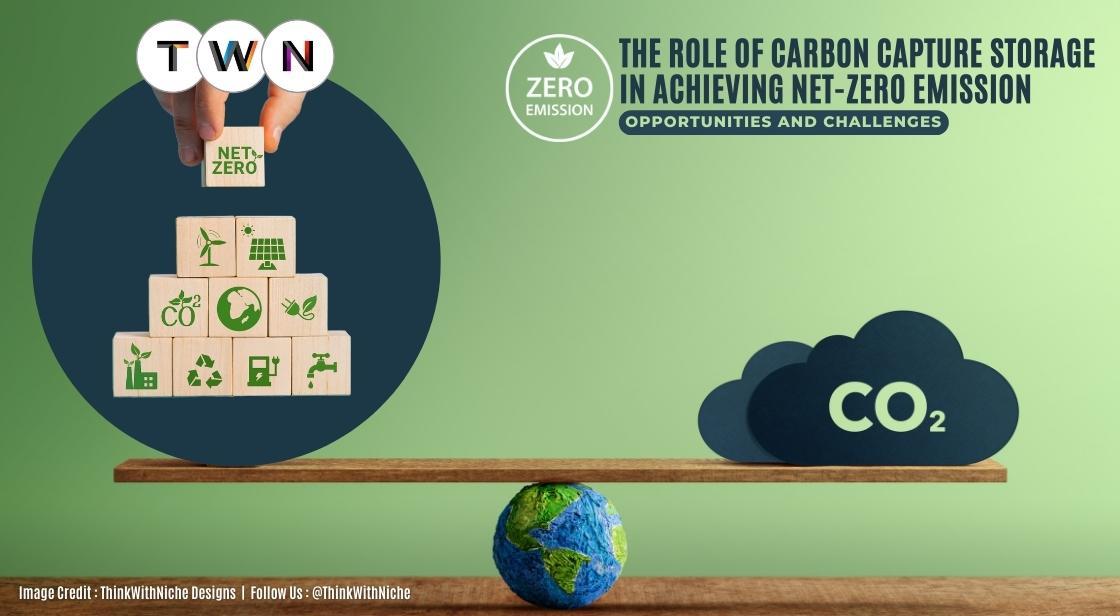The Role Of Carbon Capture Storage In Achieving Net-Zero Emissions: Opportunities And Challenges

Blog Post
This article discusses the role of carbon capture storage (CCS) in achieving net-zero emissions and its potential as a crucial solution for reducing greenhouse gas emissions and mitigating the impact of human activity on the environment. While CCS offers promising opportunities, there are still challenges that need to be addressed before it can be implemented on a large scale.
In order to achieve net-zero emissions and limit the impact of climate change, it is essential to explore and utilize all available solutions. CCS is one such solution that can significantly reduce carbon emissions from industrial sources. However, the deployment of CCS faces several challenges, including high costs, public perception, and a lack of policy incentives.
To address these challenges, governments and businesses need to collaborate and invest in CCS research and development. Policies such as carbon pricing, subsidies, and tax incentives can also be implemented to encourage the adoption of CCS technology.
Moreover, public awareness and acceptance of CCS need to be increased through education and outreach initiatives. Building trust and understanding among communities about the potential benefits and risks of CCS can help to promote its widespread adoption.
The article emphasizes the need for collaboration between governments, businesses, and individuals to ensure the effective and efficient use of this technology across all sectors of society.
The world is quickly transitioning to a low-carbon economy, and carbon capture storage (CCS) is seen as one of the most promising technologies for achieving net-zero emissions. CCS involves capturing carbon dioxide from industrial sources such as power plants and storing it underground in geological formations or oceans.
This process can help reduce global greenhouse gas emissions by up to 90%, making it an important tool in the fight against climate change. Protecting the environment is of paramount importance in the fight against climate change. The effects of global warming are already being felt across the world, with rising sea levels, extreme weather events, and the loss of biodiversity increasing in severity each year. Carbon capture storage (CCS) represents a crucial solution for reducing greenhouse gas emissions and mitigating the impact of human activity on the environment.
However, there are still many challenges that need to be addressed before CCS can be implemented on a large scale. We will look at the opportunities and challenges associated with using CCS to achieve net-zero emissions.
We will also discuss how governments, businesses, and individuals can work together to make sure that this technology is used effectively and efficiently across all sectors of society.
Overview Of Carbon Capture Storage
Carbon capture storage (CCS) is a process that captures carbon dioxide emissions from industrial sources and then stores it away underground in geological formations or oceans. This technology can be used to reduce global greenhouse gas emissions by up to 90%, making it an important tool in the fight against climate change.
CCS can be applied to both new and existing power plants, as well as industrial processes such as steel and cement manufacturing. CCS can capture carbon dioxide from the flue gas of coal-based power plants, or it can be injected directly into the ground in the form of compressed liquid carbon dioxide (CLC).
When CCS is used in combination with renewable energy sources, it can be used to achieve net-zero emissions. CCS technology is still in its early stages, but the potential exists to reduce global carbon dioxide levels significantly when implemented on a large scale.
This could lead to cleaner air and water quality, as well as reduced health risks associated with air pollution. Government incentives are needed to make CCS an economically viable option for businesses and industries.
Governments should also encourage research into the technology to ensure its successful implementation. In addition, consumers should be made aware of the benefits of CCS so that they can make informed decisions about their energy use.
Overall, CCS has the potential to be a key part of our net-zero future, but there are still challenges that need to be addressed.
Opportunities And Challenges Of Ccs
Although carbon capture storage is seen as a promising technology for reducing global greenhouse gas emissions, there are still many opportunities and challenges associated with its use.
One of the key opportunities is that CCS can be used on both new and existing power plants, as well as industrial processes such as steel and cement manufacturing.
This makes it an attractive option for many businesses and industries looking to lower their carbon footprint.
Another opportunity is that CCS can capture carbon dioxide from the flue gas of coal-based power plants, or it can be injected directly into the ground in the form of compressed liquid carbon dioxide (CLC).
This can reduce global carbon dioxide levels significantly when implemented on a large scale.
Challenges To Implementing Ccs
Despite the many opportunities associated with CCS, there are also a number of challenges to its implementation. One of the main challenges is that CCS can be expensive and technologically complex. This makes it difficult for businesses to implement the technology on their own.
In addition, there is still some uncertainty around how well CCS will work in practice, and further research is needed to ensure its success.
Another challenge is that CCS requires a large amount of energy for the capture process, which can make it difficult for businesses to be cost-effective.
Lastly, there are also regulatory hurdles and public acceptance issues that need to be addressed before CCS can be used in many countries.
Overall, CCS has the potential to make a significant difference in our fight against climate change, but there are still many challenges that need to be addressed before it can be implemented efficiently across all sectors of society.
Governments and businesses should work together to ensure the success of this important technology.
Also Read: Sustainable Business need of the hour
Solutions To The Challenges Of Carbon Capture And Storage
In order to overcome the challenges associated with carbon capture storage (CCS), there are a number of solutions that need to be implemented. One solution is for governments to provide incentives and grants for businesses and industries to invest in CCS technology.
This would help offset some of the costs involved with implementing CCS, which can be prohibitively expensive for many businesses. Governments should also invest in research and development of the technology to ensure it is efficient and cost-effective when implemented.
Another solution is for governments to partner with experts in the field to provide educational resources about CCS, which can help dispel some of the public's misconceptions about this technology.
This will create a greater level of public acceptance and understanding, which is necessary for the successful implementation of CCS.
Lastly, governments should work with industry to provide clear regulatory frameworks and guidance on how companies can use CCS in an effective and responsible manner.
By implementing these solutions, we can ensure that CCS has a positive impact on our environment.
Final Word
Carbon Capture and Storage (CCS) is a promising technology for reducing global greenhouse gas emissions, but there are still many challenges that need to be addressed before it can be implemented successfully.
Governments and businesses must work together to provide incentives, grants, research and development opportunities, educational resources on CCS, as well as clear regulatory frameworks in order to ensure its successful implementation across all sectors of society.
With the right solutions in place, we can make sure that CCS plays an important role in our fight against climate change.
You May Like
EDITOR’S CHOICE












